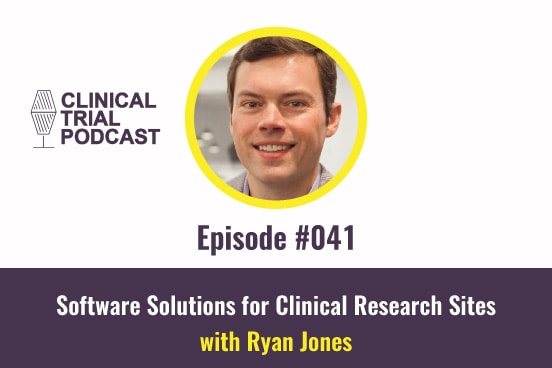As the clinical research ecosystem becomes more site and patient centric, I was curious about what an ideal software stack looks like for clinical research sites.
It goes without saying you need a laptop and stable internet connection to do business in this day and age.
But what else do you need to keep yourself organized as a clinical research site?
How can a clinical trial site bring most value to their research participants, run a profitable research operation, and not overwork employees with administrative tasks?
To answer these questions and more, I invited Ryan Jones to join me on the show. If this is your first time listening to Ryan, I also invite you to check out my earlier interview with Ryan, Solving Clinical Research Problems Using Technology, episode #12, of the show.
Aside from the technology discussion, I’m a huge fan of the company culture that Ryan and his leadership team at Florence Healthcare have created for their employees. We wrap up the episode with a couple of great book recommendations that you might be interested in reading.
I hope you enjoy my conversation with Ryan Jones.
Ryan Jones on LinkedIn and Twitter
Florence Healthcare on LinkedIn and Twitter
Sponsor
Florence Healthcare: Transform your Clinical Trials with the #1 Platform for Electronic Document Workflows and Remote Site Access.
Learn how Florence Healthcare helps over 10,000 research sites, sponsors, and CROs across 44 countries take their day back from paper
Show Notes
[4:12] History of technology adoption with clinical research sites from electronic medical records (EMR) to Clinical Trial Management System (CTMS) (tracks patients, visits, billing)
[7:00] Technology stack for clinical research sites
- Clinical Trial Management System (CTMS) to track the studies
- Workflow tools like electronic investigator site file to collect the content
- E-Source to collect the data at the patient bedside
- E-Consent to conducting the consenting process
- E-Pro (Patient Reported Outcomes) to collect the data, and to manage and create repeatable processes for collecting the data or interfacing with the EMR at the site to collect the data
- Patient Recruitment and Tracking to add new patients and stay in communication and manage their journey through the trial once they’ve enrolled
[9:47] Addressing redundancy between site and sponsor software solutions and sites taking control of their technology stack
[11:39] Setting up sites for specific protocol was like setting up a movie set
[14:22] Invention of Electronic Data Capture (EDC) and the software’s focus on clinical data transcription
[15:50] EDC and e-TMF (Trial Master File) for Investigator Initiated Studies (IIS)
[16:36] If it is an interventional study, you get into things like randomization technologies, and IP delivery or drug delivery, and drug tracking tools
[17:24] Are large academic centers slow to adopt new technologies needed to ramp up their research operation?
[20:42] Shared Investigator Platforms (SIP) – what is it and how it impacts the site’s workflow, how it relates to Florence’s electronic Investigator Site File (eISF)
[23:22] Three ways how sites get to utilize software at clinical research
(a) Sponsor deploy software at the Site just for the study and then taking it away at the end of the study is burdensome for sites
(b) Site decides and buys their own software technology and asks for Sponsor reimbursement
(c) Common software platform between Site and Sponsors i.e. Shared Investigator Platforms (SIP)
[24:16] Do sites have the skills to get reimbursed for clinical research software technology? What has the site’s experience been before and after the pandemic?
[26:11] Nonprofit vs. for-profit clinical trial site perspectives on research projects
[28:00] Rise in permanent remote work including remote monitoring visits as CRAs are not allowed on site and CRCs are working remotely, The Great Resignation and tight labor market
[30:34] Jobs going remote and how a clinical research associates (CRAs) role has and will continue to evolve (ex: not having to travel as much and leveraging risk based monitoring software to perform monitoring activities)
[32:02] Big problems in research requiring increase need for software
(a) remote collaboration between CRAs and sites (ex: remote monitoring)
(b) trying to scale research operation with difficulties in trying to hire more staff
(c) competitive differentiation (ex: technology makes it easier to work with sponsors)
[33:21] Define the problem, conduct demos, discuss how the software can solve the problem or address the business need. Do not focus on the features.
[34:00] Should you purchase off-the-shelf software applicable to more than one industry or software designed/engineered specifically for the clinical research industry?
[37:11] Quickest path to getting up to speed with new software technology?
[42:17] Technology adoption at integrated vs. disintegrated organizations, with and without senior leadership support
[43:18] Technology automates but it also standardizes. You have to have to help manage a transition into a standard way of doing things. Research sites have Standard Operating Procedures (SOPs) and technology enforces SOPs.
[44:05] Impact of software technology in small to medium size clinics with little to no research experience
[46:55] Why is research hard for a lot of physicians?
[53:14] Culture at Florence Healthcare (a) giving employees the flexibility to choose the problems they want to solve (b) challenging interview process that allows Florence to get to know the potential candidate and vice versa
Resources Mentioned:
Florence Digital Research Academy – Certification Program
Joy, Inc.: How We Built a Workplace People Love by Richard Sheridan
No Rules Rules: Netflix and the Culture of Reinvention by Reed Hastings







